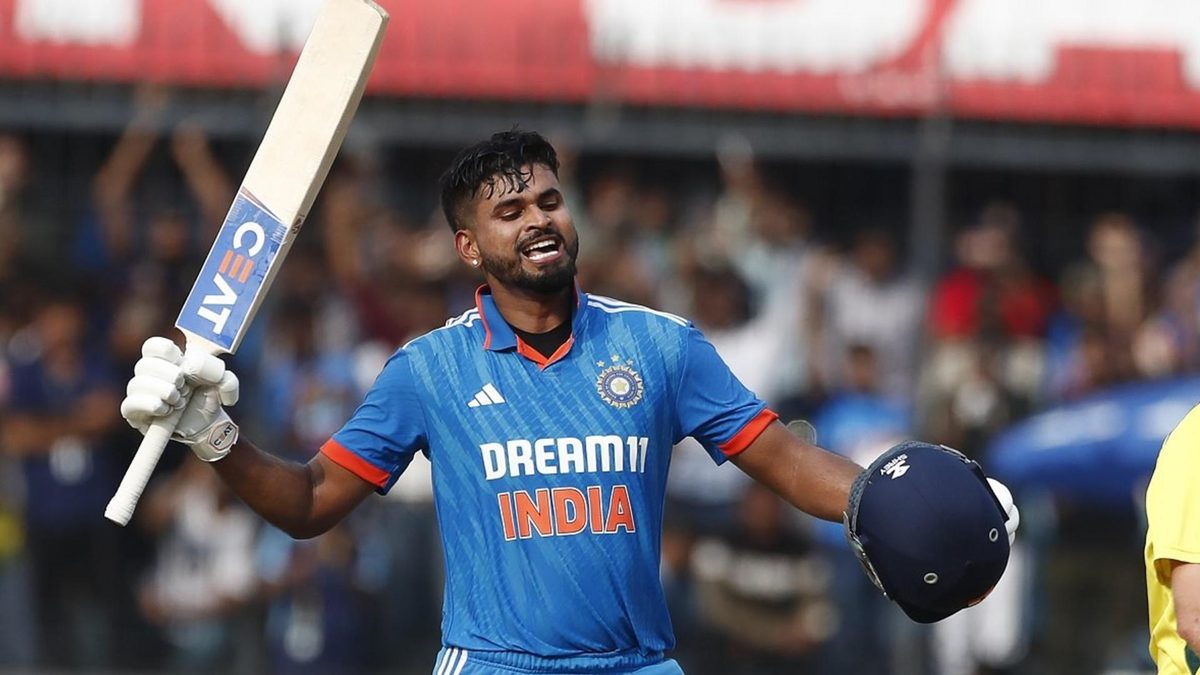
Not that there was any doubt over it, but with a dazzling hundred, Shreyas Iyer has stamped his claim as India’s ODI No.4, writes Abhishek Mukherjee.
In 2022, Shreyas Iyer made 724 runs – the most by any0ne in men’s ODIs from an ICC Full Member nation – while averaging 55.69 and striking at 92.
Topping the runs charts is not something one usually associates with someone who almost always bats outside the top three, but Iyer is no ordinary No.4: as of today, only AB de Villiers and Eoin Morgan have more runs at that position with a higher average and strike rate.
After that golden year of 2022, Iyer should have been among the first to be selected for India’s World Cup squad. Then came the lower-back pain that ruled him out of batting in the Ahmedabad Test against Australia, then from the ODIs, then the IPL, then the World Test Championship final.
Iyer did not turn up even for the West Indies. In Rohit Sharma, Shubman Gill, and Virat Kohli, India had a top three capable of keeping even Shikhar Dhawan out. They were also set to play two all-rounders at six and seven.
For four and five, they needed to choose two batters, one of them capable of keeping wicket. In Iyer’s absence, KL Rahul and Rishabh Pant would have walked in, but India were without them as well.
They resorted to the most obvious solution, of picking Suryakumar Yadav – a bonafide T20I legend at that position – and backed him even when it did not work out.
“Honestly, this was our last chance to be able to try out some of our players. We’ve got few of our players who are injured, who are in the NCA. With a month to go for the Asia Cup, we are kind of running out of time in a lot of ways,” India head coach Rahul Dravid admitted during the West Indies tour.
Thankfully for Dravid, and India, 21st-century medical science ensured Rahul and Iyer returned for the Asia Cup, along with fast bowlers Jasprit Bumrah and Prasidh Krishna.
“I’m truly happy to be where I am right now, because I never imagined I would recover so fast,” Iyer admitted to ESPNcricinfo.
In Ireland, Bumrah and Prasidh had already demonstrated that they were match-fit, at least for Twenty20 cricket. Rahul and Iyer, on the other hand, came into the Asia Cup based on match-simulation training and minor match practice. Rahul was not even fully fit.
In his comeback match, Iyer walked out to bat after India lost Rohit and Kohli inside seven overs. Shaheen Shah Afridi had begun the day on a wayward note, but a rain break had allowed him to find his rhythm.
At the other end, Iyer picked up two twos off Haris Rauf, then drove him for two fours. Rauf tried a bouncer in his next over, but Iyer saw it early, went on to the back foot, and middled the pull… only to find the only fielder in the vicinity of the shot.
Iyer did not get to bat against Nepal, and back spasms kept him out of the rest of the Asia Cup. India’s other headache – Rahul’s form and fitness – was addressed, for he made a rollicking hundred in the Super Fours match against Pakistan, and kept wicket without fuss.
Iyer’s form was among the several questions that loomed as India embarked upon the series against Australia. The team management obviously considered him fit enough to play, but was he still as good?
Would he still edge past Ishan Kishan, who – unlike Iyer – is a left-hander, can keep wicket, can open as well as bat in the middle order, and did not squander his chance against Pakistan?
The first ODI was as tailor-made for him as they make them. Slated to bat at No.3 in Rohit and Kohli’s absence, he came out at 142-1: at that point, India needed 140 in 172 balls. Two overs later, he was run out after a miscommunication with Gill.
Iyer’s post-recovery phase – three ODIs, two innings, and two unfortunately dismissals – revealed little about his form. He had not struggled (if anything, he looked fluent), but he had not spent time at the crease either. If anything, ‘SKY’ joined Kishan to add to the list of alternatives at No.4 with a 49-ball 50.
Then, in the second ODI, Iyer emerged in the fourth over, began with six fours off the first 16 balls, and hit five more shots to the ropes and three over it.
He matched the in-form Gill stroke for stroke, and beat him to the hundred. By the time he fell, for a 90-ball 105, the questions looming over India’s No.4 have been answered.
Surya made an unbeaten 37-ball 72 and Kishan slammed 31 in 18 balls to strengthen their claims, but for much of 2023, they were stopgap replacements for Iyer.
As Dravid had pointed out, “We have to try out other people and we have to give other people some chances so that in a worst-case scenario, at least they have game time behind them.”
Unless one of them breaks down, Iyer and Rahul’s returns have sealed India’s top five. Outrageous strokeplayers that they are, Kishan and Yadav will probably have to wait for their opportunities.








